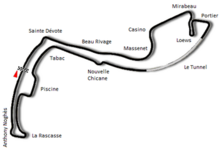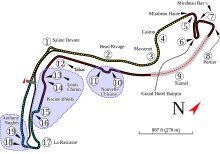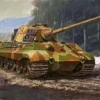Biggest leaps in performance?
#1

Posted 05 April 2015 - 17:53
Now seeing as the only rule changes were having to use one engine over the weekend you'd think the times would have been slower than 03, where did the massive leap in performance come from?? Makes this years leap look tiny in comparison.
#3

Posted 05 April 2015 - 18:28
Schumacher's time is amazing and it shows the F2004's performance. Still 13 drivers were faster in 2004 than Raikkonen's 2003 FL including Nick Heidfeld in a rather uncompetitive Jordan.
The tyre war might certainly a reason and we also shouldn't forget that the 2003 race started on a wet track. Later on it got completely dry but of course the rubber on the track had been washed away by then.
#4

Posted 05 April 2015 - 18:40
#5

Posted 05 April 2015 - 18:50
2004 was also the fastest year in F1 laptime wise, and because of that one of the best on technical aspects. It was after this year the FIA madness began with safety and stuff, resulting in the Formula 1 we have nowadays.
#6

Posted 05 April 2015 - 19:36
Did they not also qualify on full fuel tanks too?
#7

Posted 05 April 2015 - 20:12
#8

Posted 05 April 2015 - 20:32
Nope,in 2004 there where two qualifying sessions: the first one decided the running order of the so called Q2,which really decided grid positions based on lap times set by cars loaded on race fuel
#9

Posted 05 April 2015 - 22:08
2000 to 2001 was a bigger jump. We went from pole being a 1:30.5 to a 1:26.8, nearly 4 seconds and I think some races saw improvements of as much as 5 seconds per lap. 90% was entirely down to Michelin joining the sport and them and Bridgestone developing supper sticky tyres.
It's also surprising to see Raikkonen had the fastest lap in 03 since the McLaren was slower than both the Ferrari and Williams that year, though as already pointed out that race did start out wet and I remember Schumy spent a fair bit of time stuck behind him so I guess the ultimate times from that year could have been notably faster with a fully dry race.
Edited by Imateria, 05 April 2015 - 22:11.
#10

Posted 05 April 2015 - 23:14
2003 was the year they had the one lap qualifying.
2002, Pole time: Barrichello 1:25.843, Fastest race lap: Raikkonen 1:28.541 Cloudy Weekend
2003, Pole time: Schumacher 1:27.173 Fastest race lap: Raikkonen 1:27.724 Damp weekend
2004, Pole time: Schumacher 1:24.408 Fastest race lap: Shumacher 1:24.125 Dry Weekend
The progress from 2002-2004 wasn't a huge leap, 2003 was just an off year because of the weather and the slightly different rules.
And for fun:
2015 Pole time: Hamilton 1:26.327, Fastest race lap: Hamilton 1:30.945
Progress?!?!
Edited by johnmhinds, 05 April 2015 - 23:21.
#11

Posted 06 April 2015 - 00:09
The 2004 cars would have obliterated todays cars.
Did they not also qualify on full fuel tanks too?
i dont believe theyve ever done that in the modern era. When they got rid of single lap quaifying, cant remember the year, they used to start the qualifying session with their race start fuel load, and for every lap completed in qualifying the FIA would credit them back a calculated amount of fuel to refill for the start. The teams were doing dozens of laps in qualifying before setting a proper time to reduce the weight and they even took advantage by using less fuel during qualifying than the FIA would credit back.
#12

Posted 06 April 2015 - 00:36
2003 was the year they had the one lap qualifying.
2002, Pole time: Barrichello 1:25.843, Fastest race lap: Raikkonen 1:28.541 Cloudy Weekend
2003, Pole time: Schumacher 1:27.173 Fastest race lap: Raikkonen 1:27.724 Damp weekend
2004, Pole time: Schumacher 1:24.408 Fastest race lap: Shumacher 1:24.125 Dry Weekend
The progress from 2002-2004 wasn't a huge leap, 2003 was just an off year because of the weather and the slightly different rules.
And for fun:
2015 Pole time: Hamilton 1:26.327, Fastest race lap: Hamilton 1:30.945
Progress?!?!
It is amazing progress considering the constraints put on the cars for the past few years.
They are using 33% less fuel IIRC, probably half the aerodynamic surfaces, and most importantly - control tires.
#13

Posted 06 April 2015 - 00:50
1996-1997? or 1997-1998?
Largely because of Tire wars... Bridgestone vs Goodyear.
Edited by George Costanza, 06 April 2015 - 00:52.
#14

Posted 06 April 2015 - 01:02
This is probably of limited value given that Monaco is so unique, but the calculations here are interesting-
http://www.motorspor...nfo/spd_mon.htm
After a quick look, it seems the single biggest increase in average speed year-to-year occurred between '96 and '97, which as mentioned is mostly down to the tire war.
#15

Posted 06 April 2015 - 11:12
Nope,in 2004 there where two qualifying sessions: the first one decided the running order of the so called Q2,which really decided grid positions based on lap times set by cars loaded on race fuel
Ah, of course! Remember it now.
#16

Posted 06 April 2015 - 11:43
This is probably of limited value given that Monaco is so unique, but the calculations here are interesting-
http://www.motorspor...nfo/spd_mon.htm
After a quick look, it seems the single biggest increase in average speed year-to-year occurred between '96 and '97, which as mentioned is mostly down to the tire war.
Wasn't 97 the year they opened up the swimming pool area?
Edit: Yup.
Circuit layout in 96:
http://en.wikipedia....Monaco_1986.png

Circuit layout in 97:
http://en.wikipedia....1_track_map.svg

That is what knocked a bunch of time off the lap that year.
Edited by johnmhinds, 06 April 2015 - 12:06.



















